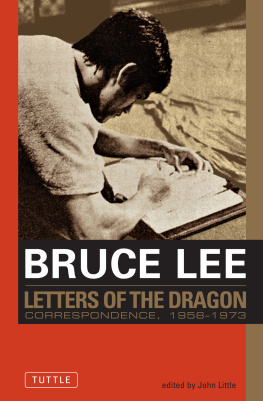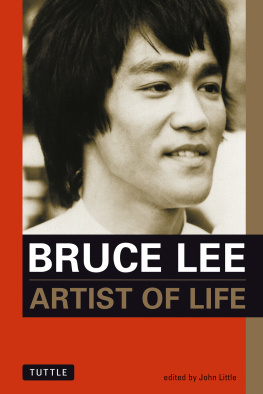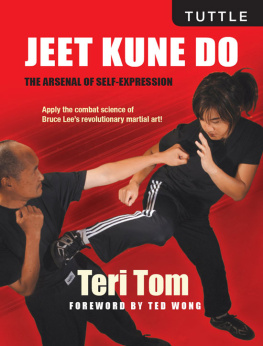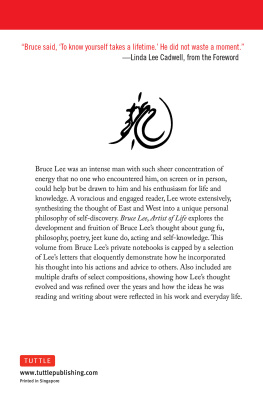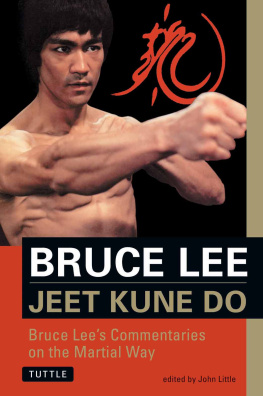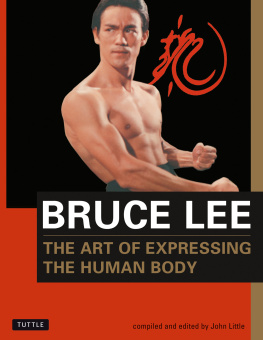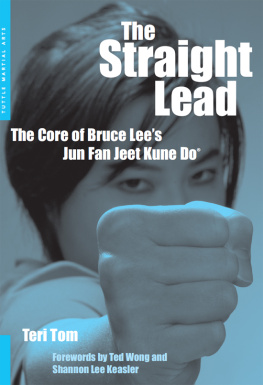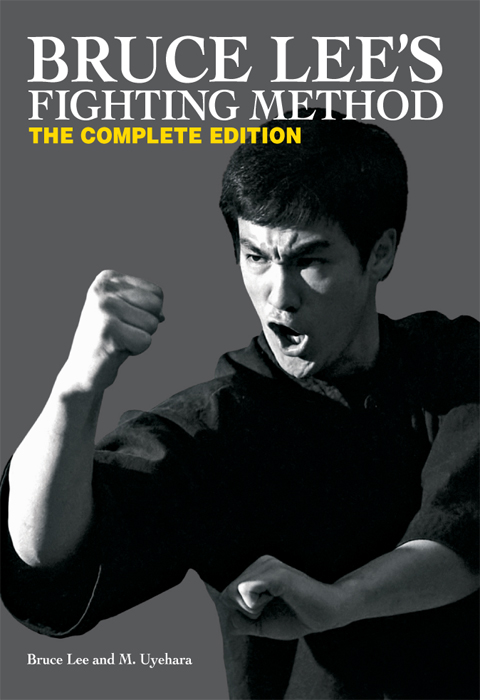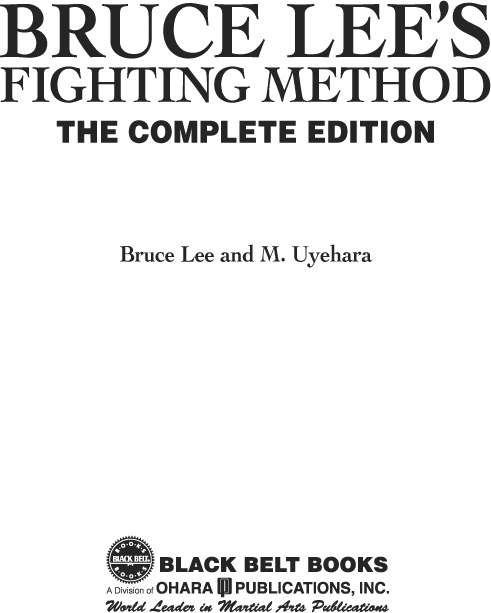Edited by Sarah Dzida, Jon Sattler and Jeannine Santiago
Art Design by John Bodine
Project Supervision by Raymond Horwitz
Copyright 1977, 1978, 2008 by Bruce Lee Enterprises LLC
All Rights Reserved
Printed in South Korea
Library of Congress Control Number: 2008933954
eISBN: 978-0-89750-250-4
First Printing 2008
BRUCE LEE, JUN FAN JEET KUNE DO, the Bruce Lee likeness and symbols associated with Bruce Lee are trademarks and copyrights of Bruce Lee Enterprises LLC. Any use of the foregoing in this book is used with the express and prior permission ofBruce Lee Enterprises LLC. All rights reserved.
WARNING
This book is presented only as a means of preserving a unique aspect of the heritage of the martial arts. Neither Ohara Publications nor the author make any representation, warranty or guarantee that the techniques described or illustrated in this book will be safe or effective in any self-defense situation or otherwise. You may be injured if you apply or train in the techniques illustrated in this book and neither Ohara Publications nor the author is responsible for any such injury that may result. It is essential that you consult a physician regarding whether or not to attempt any technique described in this book. Specific self-defense responses illustrated in this book may not be justified in any particular situation in view of all of the circumstances or under applicable federal, state or local law. Neither Ohara Publications nor the author make any representation or warranty regarding the legality or appropriateness of any technique mentioned in this book.
Foreword
Bruce Lees original idea for Fighting Method was to write an exclusive, limited edition book (not more than 200 copies) on jeet kune do. He had the pictures taken for this purpose. The photos were taken in late 1967 after my father had coined the term jeet kune do. However, after the pictures were done, he changed his mind about publishing a JKD book. Later in 1972 and 1973, my father began to work again on sequencing these same photos and writing captions for them, so it is possible that he was reconsidering the project at that time.
For his book, Bruce Lee wanted the action to be as realistic as possible, which is why he sought out photographers who could help depict the action in real time. For many of the shots, he used a high-speed camera to capture the movements. The photos taken at Bruces school were all shot in two days. Other shots were taken in front of Bruces house, in his backyard, and outside Black Belts offices.
To ensure the action was realistic, my father also insisted that the strikes make real contact. He did not use full power when making contact because he didnt want to injure anyone, but he was adamant that the action look as real as possible. Ted Wong recalls that when he had to take a kick from Bruce Lee, he wore a kendo chest protector, but Bruce was concerned that this would not be enough. So Ted tore up cardboard boxes and stuffed the pieces into his clothing to help protect his body from the impact. And even though Ted was black and blue at the end of the day, the shoot still remains a very fond memory of his.
Without the help of Dan Inosanto, Ted Wong, Joe Bodner, Oliver Pang, Mito Uyehara, Linda Lee, and, of course, Bruce Lee, this book on Bruce Lees fighting method would never have come into being. Many thanks to Black Belt, Rainbow Publications, Ohara Publications and Active Interest Media for their help and continued support of Bruce Lees books and legacy. A special thank you to Ted Wong for his help in updating the books. We hope you enjoy this new and complete edition of Bruce Lees Fighting Method.
Shannon Lee
2008
Introduction
This book was in the making in 1966 and most of the photographs were shot in 1967. The late Bruce Lee intended to publish this book years ago but decided against it when he learned that martial arts instructors were using his name to promote themselves. It was quite common to hear comments like I taught Bruce Lee or Bruce Lee taught me jeet kune do. And Bruce may never have seen or known these martial artists.
Bruce didnt want people to use his name to promote themselves or their schools with false pretenses. He didnt want them to attract students this way, especially the young teens.
But after his death, his widow, Linda, felt that Bruce had contributed so much in the world of the martial arts that it would be a great loss if the knowledge of Bruce would die with him. Although the book can never replace the actual teaching and knowledge that Bruce Lee possessed, it will enhance you, the serious martial artist, in developing your skill in fighting.
Bruce always believed that all martial artists train diligently for one single purposeto defend themselves. Whether we are in judo, karate, aikido, kung fu, etc., our ultimate goal is to prepare ourselves for any situation.
To train yourself for this goal, you must train seriously. Nothing is taken for granted. You have to kick or punch the bag with concentrated efforts, Bruce used to say. If you are going to train without the concept that this is the real thing, you are shortchanging yourself. When you kick or punch the bag, you have to imagine that you are actually hitting an adversary. Really concentrating, putting 100 percent in your kicks and punches, is the only way you are going to be good.
If you have not read Tao of Jeet Kune Do by Bruce Lee, please read it. It was meant to complement this book, and the knowledge from both books will give you a full picture of Bruces art.
M. Uyehara
Contents
PART I
BASIC TRAINING
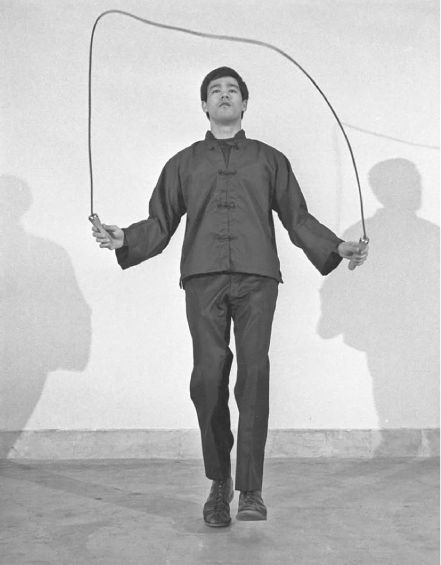
Chapter 1
The Fighting Mans Exercise
Aerobic Exercises
One of the most neglected elements of martial artists is the physical workout. Too much time is spent on developing skill in techniques and not enough in physical participation.
Practicing your skill in fighting is important, but so is maint-aining your overall physical condition. Actually both are needed to be successful in a real fight. Training is a skill of disciplining your mind, developing your power and supplying endurance to your body. Proper training is for the purpose of building your body and avoiding activities or substances that will deteriorate or injure it.
Bruce Lee was a specimen of health. He trained every day and consumed only the proper food. Although he drank tea, he never drank coffeeinstead he normally consumed milk. He was a martinet who never let his work interfere with his training. Even when he was sent to India to find suitable locations for filming, he took along his running shoes.
Lees daily training consisted of aerobic exercises plus others, which were patterned to develop his skill in fighting. He varied his exercises to avoid boredom. One of his favorite exercises was running four miles a day in 24 to 25 minutes. He would change his tempo while runningafter several miles of constant, even strides, he would sprint several feet and then return to easier running. Between changes in running tempo, he would also shuffle his feet. Lee was not particular where he ran: at the beach, in parks or woods, up and down hills or on surfaced streets, as in photo 1.


